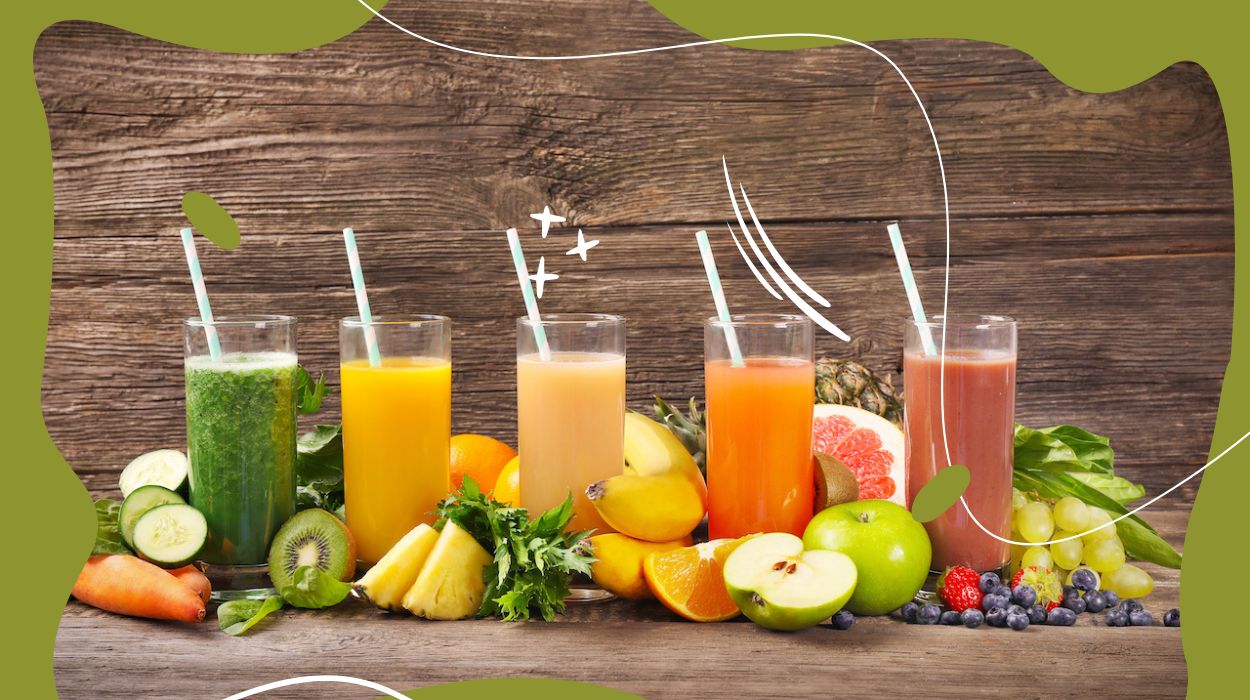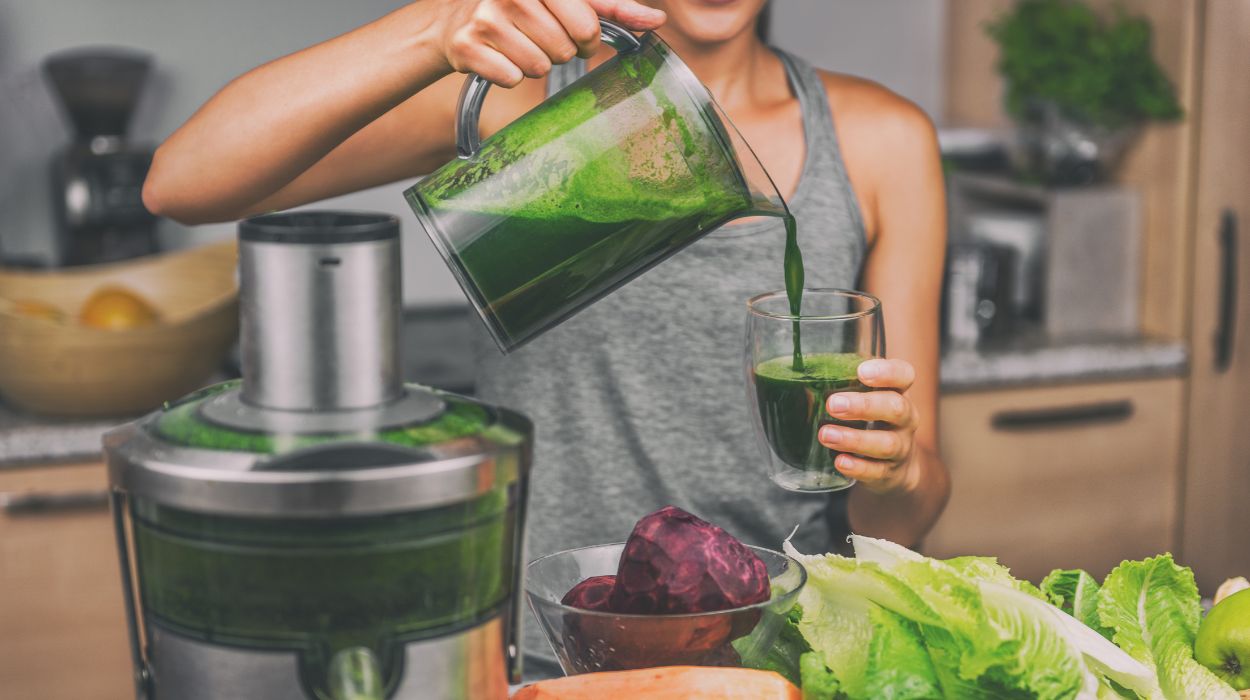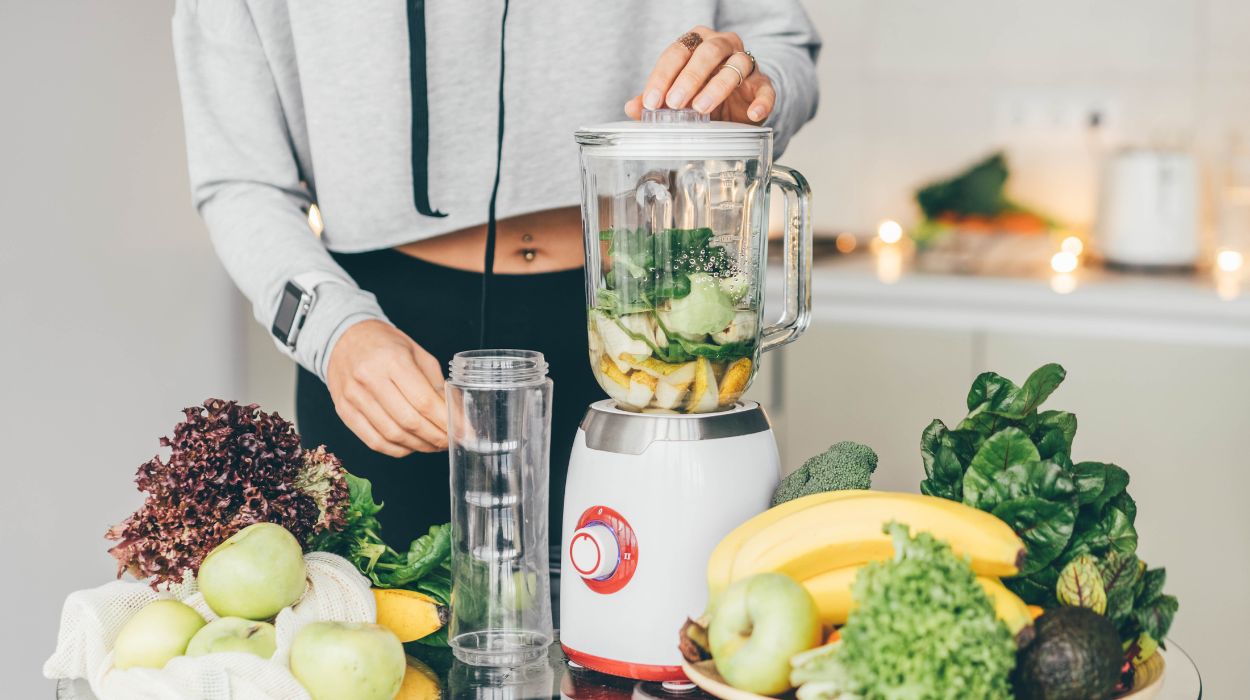 Expert's opinion
Expert's opinion
Expert's opinion
The article is a subjective view on this topic written by writers specializing in medical writing.
It may reflect on a personal journey surrounding struggles with an illness or medical condition, involve product comparisons, diet considerations, or other health-related opinions.
Although the view is entirely that of the writer, it is based on academic experiences and scientific research they have conducted; it is fact-checked by a team of degreed medical experts, and validated by sources attached to the article.
The numbers in parenthesis (1,2,3) will take you to clickable links to related scientific papers.
Juicing Vs Blending For Weight Loss 2024 – Is It Better To Juice Or Blend?

The healthy drink industry is booming across the country and the world. More people are paying attention to what they eat and drink. This explains why the fresh juice and smoothie industry is worth over $2.36 billion[1] in 2020. Accordingly, as you work on your healthy meal plans, it’s essential to understand what you eat. That means knowing which is better for weight loss between “juicing vs blending”. You can also use fruit and vegetable supplements if you don’t have access to fresh products.
Every healthy diet plan requires changing what you eat to achieve your weight loss goals. If you keep eating and drinking the same food, chances are you won’t see many results. Among the food items to add to your meals are fruits and vegetables[2]. This article explores the two ways of making healthy drinks and their benefits. With this knowledge, you can make crucial decisions.
Juicing Vs Blending For Weight Loss
By understanding the two healthy drink preparation methods, we think you will agree that blending is the best option for weight loss. Whole fruit and vegetables are so beneficial to the human body. They are low in calories and carry loads of essential vitamins and minerals. Once you start consuming them, they should be as fresh as possible.
For many people, this means preparing salads. However, you can also juice or blend the fruits and vegetables to get fresh juice or smoothies. Drinking juice or smoothie means you can enjoy the drinks while consuming healthy treats.
What’s The Difference Between Juicing And Blending?
Juicing
Juicing is a process that entails extracting fresh juice from vegetables and fruits. The fruits and vegetables go into a juicer which removes all solid matter. Essentially, you get rid of the seeds, pulp, and other fibrous materials.

The outcome is fresh juice full of vitamins and minerals but lacks fiber. People love to use two types of juicers, namely:
Cold Press
The cold press juicer takes time to crush the fruits and vegetables. Slowing down the process means you can get plenty more juice from these food items.
Centrifugal
Centrifugal is a faster process of extracting juice from fruits and vegetables. The juicer takes seconds to grind these food items into a pulp and separate liquid from the solid matter.
You can use either method to get fresh juice at home. They don’t have much difference when it comes to nutritional content[3].
Blending
While juicing means extracting juice from fruits and vegetables, blending is the opposite. Unlike juices, fiber remains in a smoothie. Blending smoothies produces a thick, nutritious drink[4]. When you want to prepare a smoothie, you need a good blender.
Start by gathering your ingredients which include fresh fruits and vegetables. Slice them into smaller pieces, place them in the blender with water or a healthy drink, and blend. You won’t need to get rid of the seeds or pulp during this process.
They are blended to give you a rich and creamy liquid. There’s no limit to what you can add to your smoothie[5] to make it healthy. Many people use fruits and vegetables as the base but also add ingredients such as:
- Nuts (groundnuts, cashew nuts, walnuts)
- Seeds (chia seeds, flax seeds, sunflower seeds)
- Herbs (dill, basil, thyme)
- Spices (ginger, turmeric, cinnamon)
- Herbal supplements (matcha powder, minerals, protein powder)
- Sweeteners (stevia, honey, pitted dates)
- Liquids (water, plain yogurt, milk)
All these are excellent to add to your smoothie and still enjoy a healthy drink[6] that will not only help you lose weight but also provide health benefits.
There are three types of smoothies you can prepare at home like:
Protein Smoothies
It contains fruit, a vegetable, and a major protein source. Protein powder, plain yogurt, or cottage cheese are the healthiest protein sources. Always ensure you have regular protein intake for better health.
Green Smoothies
As the name suggests, green smoothies fit the color of green tea. The best way to make them is to include leafy greens such as fresh spinach, parsley, or cucumbers in your smoothie. Veggies are in abundance as compared to other healthy ingredients. The vegetables retain their fiber to give you a fibrous drink.
Fruit Smoothies
There are fewer vegetables and more fruits in the mix when blending smoothies. You can add other ingredients but ensure the ratio of fruits is higher than all other ingredients.

Nutritional Concentration
It’s better to master the juicing and blending process before picking one over the other. After you understand what each process entails, you can compare the two. The best way to do so is to check all the nutrients.
Nutritional content checks the number of vitamins and minerals each drink has. Which between the two is more nutritious for your body as you aim to lose weight?
Essential Fibers
Fiber is quite important[7] to the human body, especially when aiding digestion. Juicing takes away all the fiber in the form of pulp. On the other hand, blending smoothies give you a fiber drink since you don’t extract.
Your body needs fiber for numerous functions. It’s even the answer if you suffer from constipation. Fiber comes in two forms, that is:
Soluble Fiber
Soluble fiber comes from citrus, pears, apples, green beans, and carrots. It dissolves in water and helps slow down digestion and lower blood sugar levels.
Insoluble Fiber
Green veggies and cauliflower give you insoluble fiber. These bulk up your stool and stimulate bowel movement[8].
For fiber content, blending fruits and vegetables is a better option. Smoothies have lots of fiber since you don’t have to get rid of the pulp.
Sugar Content
Another crucial point to note when comparing juicing vs. blending is the sugar content of healthy drinks. One issue that both of these methods face is the high sugar content. As a result, regular consumption ends up raising your blood sugar.
However, among the two, juicing has higher sugar content[9]. The reason is, that fruit juices are lighter. It’s easy to drink more servings in one sitting. The more you drink, the higher your blood sugar levels. On the other hand, smoothies tend to be thick and filling.
After a mug or two of smoothies, you won’t feel the need to eat to drink anything else for some time. It means blending fruits and vegetables. You can reduce your calorie intake each day. This is crucial when you want to lose weight. Juices tend to not be as filling as smoothies requiring you to take more servings.
Another issue that affects juice’s sugar content is additives. These are fresh juices, but some people add sweeteners or sugar. This is a huge issue because too much sugar intake can affect your health[10] and well-being.
Blending Vs Juicing – Which Is Easier To Digest?
Which is easier to digest juices and smoothies? Both sides win when it comes to healthy digestion. With juicing, you get rid of the bulk of the pulp, which contains all the fiber. The outcome is a fresh drink that gives your digestive system a break.
Smoothies have loads of fiber and other pulp materials that the body can digest. All this keeps your digestive system going, but that isn’t necessarily a bad thing. The fibrous material is good for your health and aids in healthy digestion.
However, always keep your health in mind as you pick between juicing and blending. If your diet requires high fiber[11] content, go for blending. It can help with cancer, heart disease, and high blood pressure. If you have a condition that calls for low fiber[12] content, pick juicing to ease digestion. But, ensure you consult a doctor to provide medical advice.
Juices Or Smoothies For Antioxidants
Antioxidants are quite crucial to your body. They protect the cell walls in your body against free radicals[13] known to cause a whole host of illnesses. The excellent news is you can get antioxidants in sweet fruits and vegetables that you eat each day.
When picking between juicing vs. blending process, it’s best to consider the antioxidant content in the final drink. Research[14] shows that blending is a better option when you want a high antioxidant content in your daily servings.
In essence, antioxidants are more present in the membrane of the sweet fruit than in the water content. Therefore, by getting rid of the pulp, you essentially get rid of most of the antioxidants crucial to the immune system.
Conclusion
Juicing is a process that gives you a healthy drink made from whole fruits and vegetables. Fresh juices have loads of beneficial minerals and vitamins depending on the vegetables and sweet fruits you use. However, they lack fibrous parts, which are crucial for your health.
You get a more nutritious drink when you opt to blend your food items. Blending doesn’t get rid of any pulp, seeds, or fiber. But not everyone likes the creamy nature of blended smoothies, so consider this as you pick between the two.
When you blend, you can also be diverse in the drinks that you make. Many healthy additives like nuts, seeds, supplements, and liquids are available. When you choose the most beneficial options, you wind up with a healthier drink.
All in all, blending is the best option when you want to lose weight. This is because juicing requires removing the bulk of the pulp. As a result, you can drink loads of it in a day, increasing your blood sugar levels.
However, blended smoothies are thick and filling, so you only need to drink a glass at a time as you work on healthy habits.
+ 14 sources
Health Canal avoids using tertiary references. We have strict sourcing guidelines and rely on peer-reviewed studies, academic researches from medical associations and institutions. To ensure the accuracy of articles in Health Canal, you can read more about the editorial process here
- Statista. (2022). Juice and smoothie bar sector market size US 2022 | Statista. [online] Available at: https://www.statista.com/statistics/1176158/juice-and-smoothie-bar-industry-market-size-us/.
- Pem, D. and Jeewon, R. (2015). Fruit and Vegetable Intake: Benefits and Progress of Nutrition Education Interventions- Narrative Review Article. Iranian journal of public health, [online] 44(10), pp.1309–21. Available at: https://www.ncbi.nlm.nih.gov/pmc/articles/PMC4644575/.
- Gholamreza Khaksar, Kitipong Assatarakul and Supaart Sirikantaramas (2019). Effect of cold-pressed and normal centrifugal juicing on quality attributes of fresh juices: do cold-pressed juices harbor a superior nutritional quality and antioxidant capacity? [online] 5(6), pp.e01917–e01917. doi:https://doi.org/10.1016/j.heliyon.2019.e01917.
- Mccartney, D., Rattray, M., Desbrow, B. and Christopher Garry Irwin (2018). Smoothies: Exploring the Attitudes, Beliefs and Behaviours of Consumers and Non-Consumers. [online] ResearchGate. Available at: https://www.researchgate.net/publication/327313971_Smoothies_Exploring_the_Attitudes_Beliefs_and_Behaviours_of_Consumers_and_Non-Consumers.
- Rogers, P. and Shahrokni, R.O. (2018). A Comparison of the Satiety Effects of a Fruit Smoothie, Its Fresh Fruit Equivalent and Other Drinks. [online] 10(4), pp.431–431. doi:https://doi.org/10.3390/nu10040431.
- Henning, S.M., Yang, J., Shao, P., Lee, R.-P., Huang, J., Ly, A., Mark Ming-Long Hsu, Lu, Q., Thames, G., Heber, D. and Li, Z. (2017). Health benefit of vegetable/fruit juice-based diet: Role of microbiome. [online] 7(1). doi:https://doi.org/10.1038/s41598-017-02200-6.
- Anderson, J.M., Baird, P., Davis, R.A., Ferreri, S.P., Knudtson, M., Ashraf Koraym, Waters, V. and Williams, C.M. (2009). Health benefits of dietary fiber. [online] 67(4), pp.188–205. doi:https://doi.org/10.1111/j.1753-4887.2009.00189.x.
- Kaczmarczyk, M., Miller, M.I. and Freund, G.G. (2012). The health benefits of dietary fiber: Beyond the usual suspects of type 2 diabetes mellitus, cardiovascular disease and colon cancer. [online] 61(8), pp.1058–1066. doi:https://doi.org/10.1016/j.metabol.2012.01.017.
- Murphy, M., Barrett, E.C., Bresnahan, K.A. and Barraj, L.M. (2017). 100 % Fruit juice and measures of glucose control and insulin sensitivity: a systematic review and meta-analysis of randomised controlled trials. [online] 6. doi:https://doi.org/10.1017/jns.2017.63.
- Paglia, L. (2019). The sweet danger of added sugars. [online] 20(2), pp.89–89. doi:https://doi.org/10.23804/ejpd.2019.20.02.01.
- Barber, T.M., Kopf, S., Pfeiffer, A. and Weickert, M.O. (2020). The Health Benefits of Dietary Fibre. [online] 12(10), pp.3209–3209. doi:https://doi.org/10.3390/nu12103209.
- Medlineplus.gov. (2020). Low-fiber diet: MedlinePlus Medical Encyclopedia. [online] Available at: https://medlineplus.gov/ency/patientinstructions/000200.htm.
- Rahman, K. (2007). Studies on free radicals, antioxidants, and co-factors. Clinical interventions in aging, [online] 2(2), pp.219–36. Available at: https://www.ncbi.nlm.nih.gov/pmc/articles/PMC2684512/.
- Uckoo, R.M., Jayaprakasha, G.K., Balasubramaniam, V.M. and Patil, B.S. (2012). Grapefruit (Citrus paradisiMacfad) Phytochemicals Composition Is Modulated by Household Processing Techniques. [online] 77(9), pp.C921–C926. doi:https://doi.org/10.1111/j.1750-3841.2012.02865.x.



